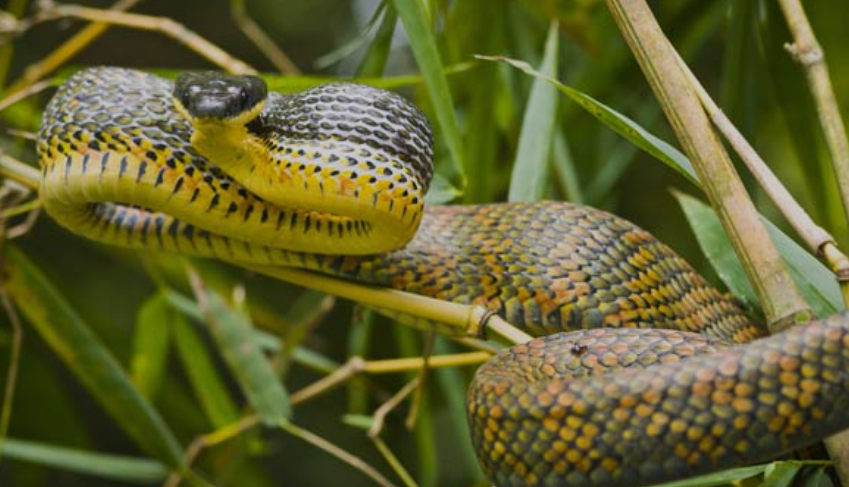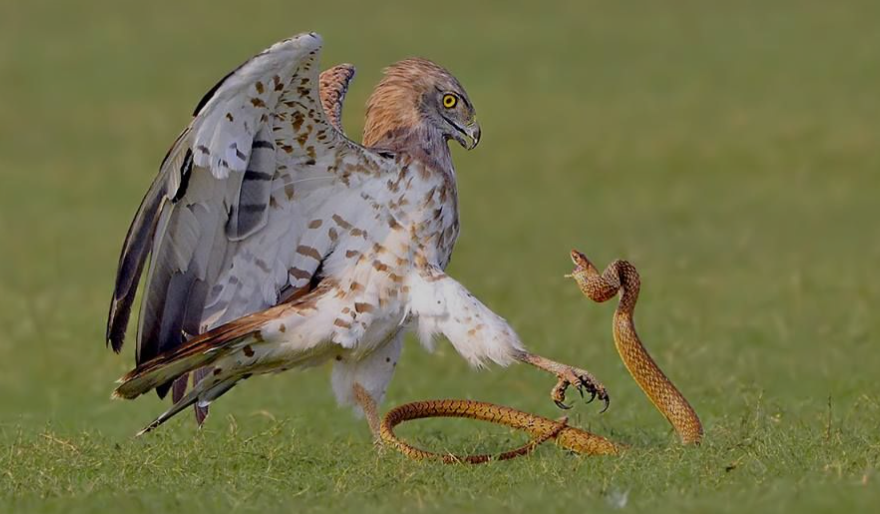
Of all the predatory relationships in the animal kingdom, few are as dramatic as the one between certain avian hunters and serpents. These birds have evolved to turn a dangerous and limbless reptile into prey, engaging in a high-stakes battle with every encounter.
Some birds have developed physical adaptations for overcoming a snake’s primary defenses. Powerful, scaly legs equipped with long, sharp talons are essential for securing a struggling victim from a safe distance. A sharp, hooked beak acts as a precise weapon, designed to deliver a swift, killing blow to the head or neck. Some species even possess a degree of immunity to venom, allowing them to survive the bite of a poisonous adversary.
Hunting strategies vary, with some species employing an aerial surveillance technique, scanning the ground from great heights before diving at incredible speeds to snatch their unsuspecting target. Others are more terrestrial, walking or running through grasslands to flush out concealed serpents. The initial attack must be perfectly executed; a missed strike gives the snake a chance to counter-attack, turning the hunter into the hunted in an instant.
For many of these birds, this diet is not just for their own sustenance but is also for raising their young. They will deliver captured serpents, often still writhing, to the nest to feed their chicks.

Birds That Eat Snakes
Secretary Bird
Native to Africa, the secretary bird is famous for its snake-hunting prowess. With long legs and powerful kicks, it stomps on snakes to immobilize or kill them before swallowing them whole. Its height and keen eyesight allow it to spot serpents in open grasslands from great distances.
Roadrunner
Roadrunners are agile ground birds of the American Southwest that frequently prey on snakes. They use their speed and strong beaks to grab and slam snakes against rocks until they are subdued. Some are even bold enough to tackle venomous species.
Red-Tailed Hawk
This adaptable hunter of North America is often seen circling fields and meadows. When it targets a snake, it doesn’t just rely on strength—it uses patience. The hawk can hover or perch for long periods, waiting for movement before diving with precision to seize its prey. Their powerful beaks then finish the kill.
Crested Serpent Eagle
As its name suggests, this eagle specializes in hunting snakes. Found in parts of Asia, it patrols forest edges and grasslands, using sharp talons and hooked beaks to subdue reptiles. Its diet is heavily snake-based compared to other raptors.
Brown Snake Eagle
This African bird of prey has developed a particular preference for snakes, including venomous cobras and vipers. Its thick, scaly legs provide protection against bites, allowing it to tackle dangerous prey others avoid.
Great Horned Owl
Great horned owls are versatile hunters and occasionally prey on snakes, especially those active at night. Their silent flight and strong talons give them the advantage, surprising reptiles in open areas.
Peacock
Though best known for their spectacular plumage, peafowl will opportunistically eat snakes. They rely on their strong beaks and quick strikes, sometimes working in groups to corner and kill larger prey.
Snake Eagle (Short-Toed Snake Eagle)
This raptor, found in Europe, Asia, and Africa, specializes almost entirely on snake hunting. It soars high to spot movement on the ground, then dives quickly to seize snakes in its talons. Its hunting skills make it one of the most specialized snake-eating birds.
Kingfisher (Laughing Kookaburra)
The kookaburra, a giant kingfisher native to Australia, is known to eat small snakes along with insects, reptiles, and rodents. Using its heavy bill, it grabs snakes, beats them against branches or rocks, and swallows them whole.
Golden Eagle
Golden eagles are powerful hunters that occasionally take on snakes as part of their varied diet. With immense strength in their talons, they can snatch snakes from the ground and carry them off with ease, often killing them mid-air.
Guinea Fowl
Guinea fowl are ground-dwelling birds often kept on farms in Africa and other regions for pest control. They are known to attack and consume snakes, sometimes working together as a flock to overwhelm larger ones.
White Stork
These tall wading birds often feed on reptiles, including snakes, while foraging in wetlands and grasslands. Unlike birds of prey, this wader hunts in a slower, deliberate manner. Moving through wetlands and grasslands, it uses its long bill like tongs to grip snakes. Its feeding style is more about opportunism, taking advantage of encounters during migration or nesting seasons.
Heron (Great Blue Heron)
While herons mainly feed on fish, they also prey on snakes when the opportunity arises. Their spear-like beaks allow them to strike quickly and capture snakes in shallow water or grass.
Hawk-Eagle (Changeable Hawk-Eagle)
This tropical raptor has a varied diet but shows a preference for snakes when available. Its powerful build and sharp talons make it capable of subduing large reptiles in dense forests and open habitats.
Crow
Crows, being highly intelligent and opportunistic, sometimes hunt or scavenge snakes. They may attack in groups, mobbing a snake until it is weakened, then feed on it together.
Bateleur Eagle
Found in Africa, the bateleur eagle specializes in hunting reptiles, including snakes. Its name means “tightrope walker,” referencing its rocking flight as it scans for prey below. Snakes make up a significant part of its diet.
Black Kite
The black kite is a widespread raptor found across Europe, Asia, and Africa. It often preys on snakes, using its sharp talons and curved beak to dispatch them quickly. Opportunistic in nature, it will also scavenge on snakes already killed by other animals.
Brown Snake Eagle
This African bird of prey is one of the most specialized snake hunters. It feeds almost exclusively on snakes, including venomous species, which it captures with strong talons and swallows whole after carefully removing their heads.
Junglefowl
Related to domestic chickens, wild junglefowl occasionally eat snakes in their native habitats of South and Southeast Asia. They use their sharp beaks to strike repeatedly, sometimes killing snakes larger than themselves.
Cattle Egret
Though often seen around grazing animals eating insects, cattle egrets also consume snakes when they cross their path. Their quick strikes and ability to swallow elongated prey make snakes a surprising but effective food source.
Greater Roadrunner
Famous in deserts of the American Southwest, the greater roadrunner is a ground-dwelling bird that specializes in catching reptiles, especially snakes. It uses speed, agility, and a strong beak to stun or kill snakes before consumption.
Raven
Like crows, ravens are highly intelligent and opportunistic feeders. They may hunt snakes directly or scavenge on dead ones, often working cooperatively to handle larger prey. Their adaptability makes snakes a steady supplement to their diet.
Caracara
Native to the Americas, caracaras are opportunistic raptors that prey on snakes among other animals. They are known for their persistence, often following snakes on the ground until an opening appears to strike with their hooked beaks.
Black-Crowned Night Heron
While primarily fish eaters, black-crowned night herons are versatile predators that will seize snakes in shallow water or wetlands. Their stealthy hunting style makes them efficient ambushers, even against quick-moving reptiles.
Laughing Kookaburra
This bird from Australia may look cheerful, but it is a fierce predator. Unlike raptors, it uses its powerful beak as a club, slamming snakes against tree trunks or rocks. Its hunting relies on brute force rather than talons, showing a very different technique from typical snake hunters.
American Kestrel
Though small, this falcon uses agility and speed to its advantage. Instead of tackling large reptiles, it focuses on smaller, more manageable snakes. Its ability to hover in place before striking allows it to target snakes hidden in grass—a technique rare among other snake-eating birds.
Crested Serpent Eagle
Found across South and Southeast Asia, this raptor specializes in hunting reptiles, especially snakes. Its name reflects its diet, and it is known to soar low over forests and grasslands before swooping down to grab snakes with strong talons.
Snake Eagle
Native to Africa, this powerful bird is almost entirely snake-dependent. It has thick, scale-like feathers on its legs that act as armor against bites, allowing it to subdue venomous species that would deter other predators.
Brown Falcon
An Australian bird of prey, the brown falcon hunts a wide range of reptiles, including snakes. Unlike high-diving raptors, it uses a slower, hovering flight and sharp ground attacks, often targeting snakes flushed out by grass fires.
Grey-Headed Fish Eagle
Though primarily a fish eater, this eagle is opportunistic and will take snakes when available. Found near rivers and wetlands across South and Southeast Asia, it swoops down with surprising power to snatch snakes near water edges.